Breakfast meets dessert in these amazing Crème Brûlée Donuts! These gourmet doughnuts feature a soft, tender homemade doughnut, a vanilla bean pastry cream filling, and a delicious crackly caramelized sugar topping.
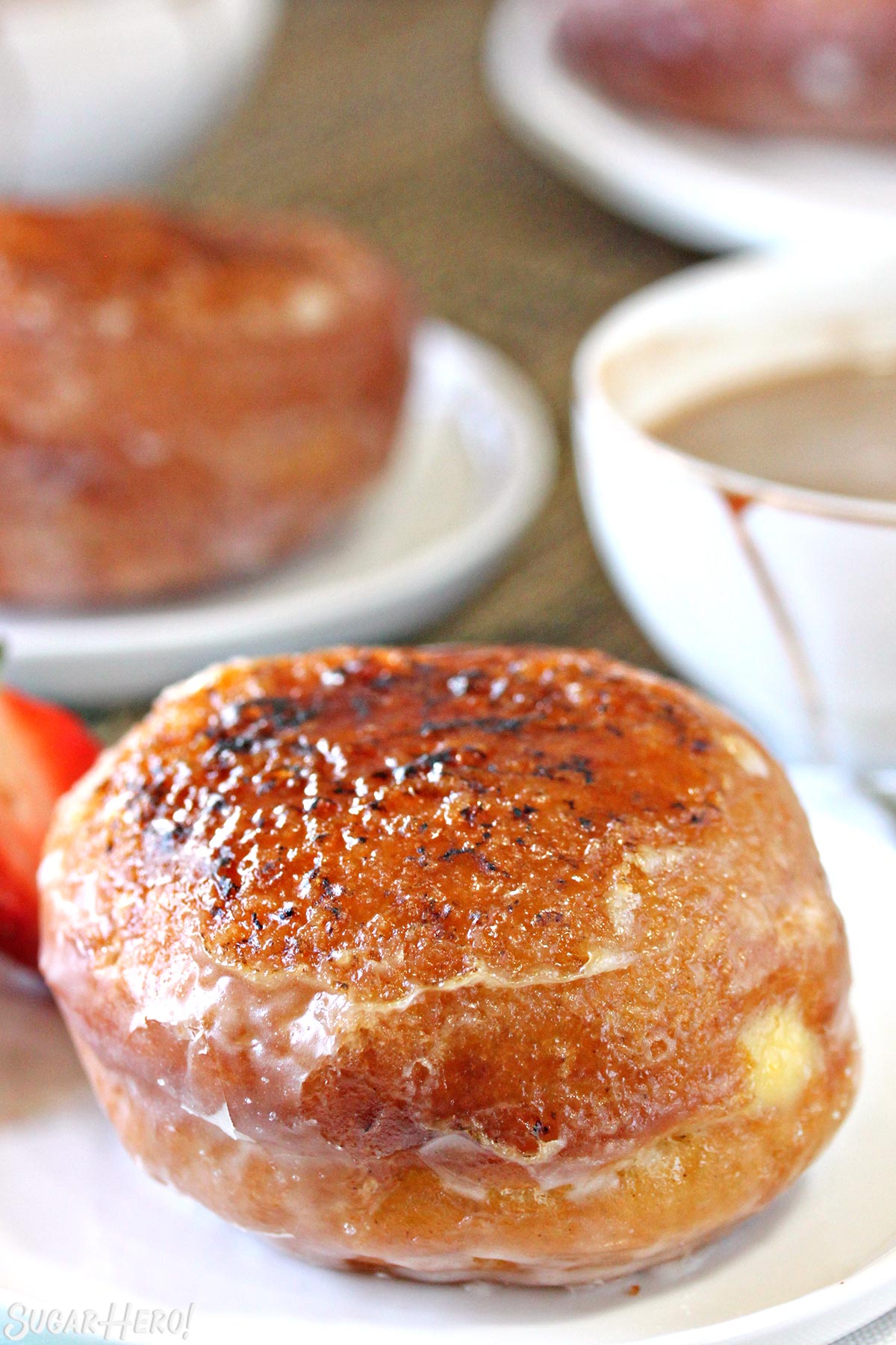
🍩 Cream-filled doughnuts inspired by crème brûlée
Up your doughnut game with these amazing Crème Brûlée Donuts. They combine all the best parts of crème brûlée AND doughnuts in one palm-sized pastry. Here are just a few reasons we love them:
- the inside is pillowy and soft,
- the outside edges are beautifully crisp
- the filling is a luscious vanilla bean-scented cream
- they’re topped with a crackly layer of deeply caramelized sugar
There are plenty of cream-filled doughnuts out there, but how many of them can boast about having a crackly sugar shell that breaks into delicious shards when you take a bite? The combination of textures and flavors put these doughnuts in a category all their own.
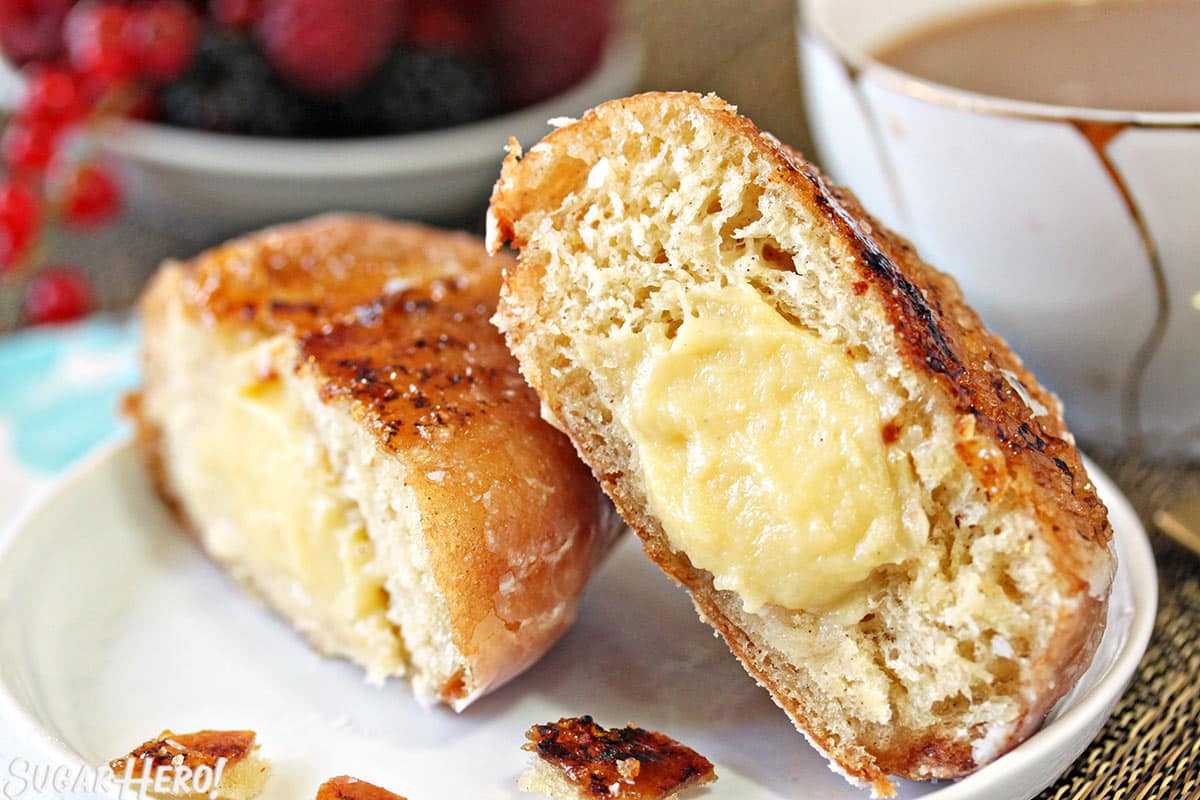
Even if you don’t like crème brûlée or pastry cream, this is a great all-purpose doughnut recipe. You can either fill them with something else (like jam, lemon curd, ganache, whipped cream or pudding), or skip the filling entirely and cut them into traditional doughnut shapes.
If you’re inspired to try other homemade doughnut recipes, don’t miss our Chocolate Blackout Doughnuts, Pumpkin Cream Filled Donuts, and Apple Donuts!
Table of Contents
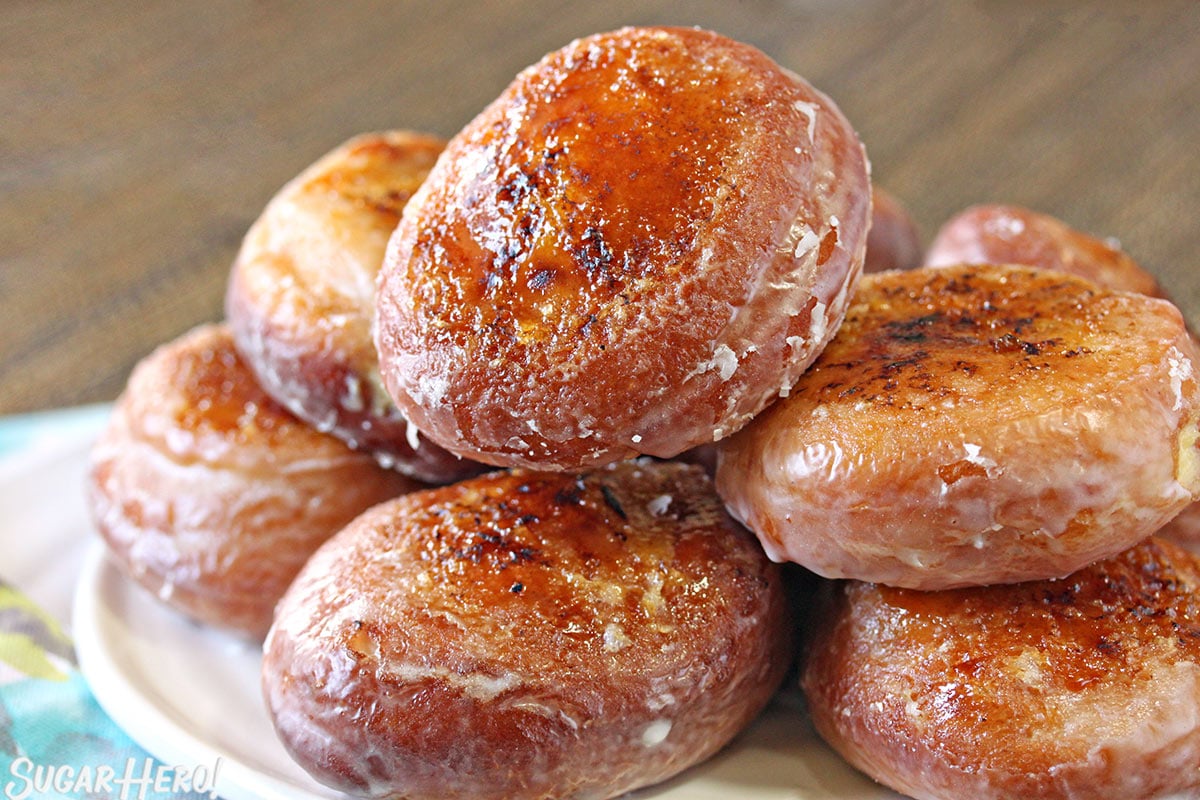
🧾 What You’ll Need
Ingredients
Here are a few important things to note as you gather your doughnut ingredients. (Links are affiliate links and I earn a small commission from qualifying purchases.)
- Active dry yeast: Yeast can quite literally make or break this recipe, so it’s very important to make sure the yeast you use is fresh and active. If your yeast is dead, or too old, the dough won’t rise and you will have hockey pucks instead of fluffy doughnuts. I recommend testing your yeast before starting the recipe (see the Yeast Tips section below for instructions!), and purchasing new yeast if you have any doubts about its potency.
- Milk: I recommend using milk with some fat in it — such as 2% or even whole — because it provides better results than skim milk. I have not tested this recipe with non-dairy milk.
- Flour: You’ll want regular, all-purpose flour for this recipe.
- Eggs: Use large eggs, and for the best results, have them at room temperature before beginning. Either let them sit out for 20-30 minutes, or submerge them in a bowl of warm water for a few minutes to warm them up quickly.
- Sugar: We’re using two kinds of sugar in this recipe: powdered sugar in the glaze, and granulated sugar in the dough, pastry cream, and caramelized topping.
- Corn starch: Corn starch is used to thicken the pastry cream. You can substitute arrowroot starch if you prefer, but don’t skip it altogether — some type of starch should be used to get the proper texture.
- Canola oil: this neutral flavored oil is a good choice for deep-frying. You can swap in another neutral flavored oil, like vegetable oil, instead.
- Vanilla bean paste: I love using vanilla bean paste in my vanilla desserts. It provides both a strong, authentic vanilla flavor and the signature vanilla bean specks you see in many desserts, and it’s much cheaper than using actual vanilla beans. If you have vanilla beans you want to use, you can swap in the seeds of 1 bean instead. You can also substitute with vanilla extract, but will probably want to use more to mimic the vibrant vanilla flavor — I typically use 1.5 to 2x as much extract as vanilla bean paste.
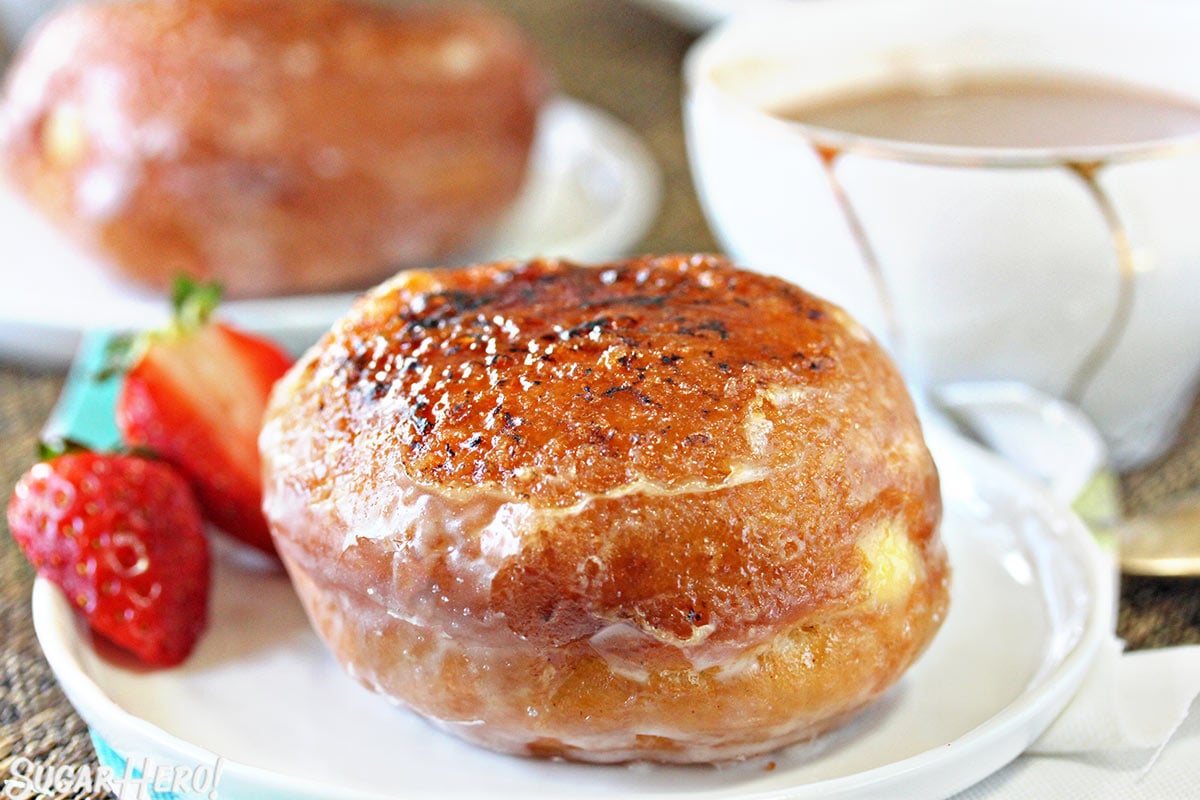
Equipment
There are a few important tools you’ll need for doughnut success: (Links are affiliate links and I earn a small commission from qualifying purchases.)
- Candy/deep-fry thermometer: A kitchen thermometer is a MUST for deep frying! You can pick one up for $10 (I love this inexpensive Taylor thermometer), and it’s also great for making caramel, toffee, and other hard candies. A thermometer helps you monitor the temperature of the frying oil, so you’ll have successful doughnuts every time. If you are new to using a thermometer, check out my guides for how to use a thermometer and how to test and calibrate a thermometer correctly.
- Kitchen torch: A butane kitchen torch is the easiest way to get that crackly caramelized sugar layer on top of the doughnuts. If you don’t have one, you can try using your oven’s broiler, but the results will be less consistent.
- Mixer with dough hook:It’s not impossible to use a hand mixer to make this dough, but a stand mixer will do a faster and easier job of it. You’ll want to use a dough hook with your mixer to knead the dough until it’s smooth and supple.
- Circle cutters: Sharp circle cutters are the best for making doughnuts. I have and recommend this versatile set of round cutters. I use it for doughnuts, cookies, tart dough, and more.
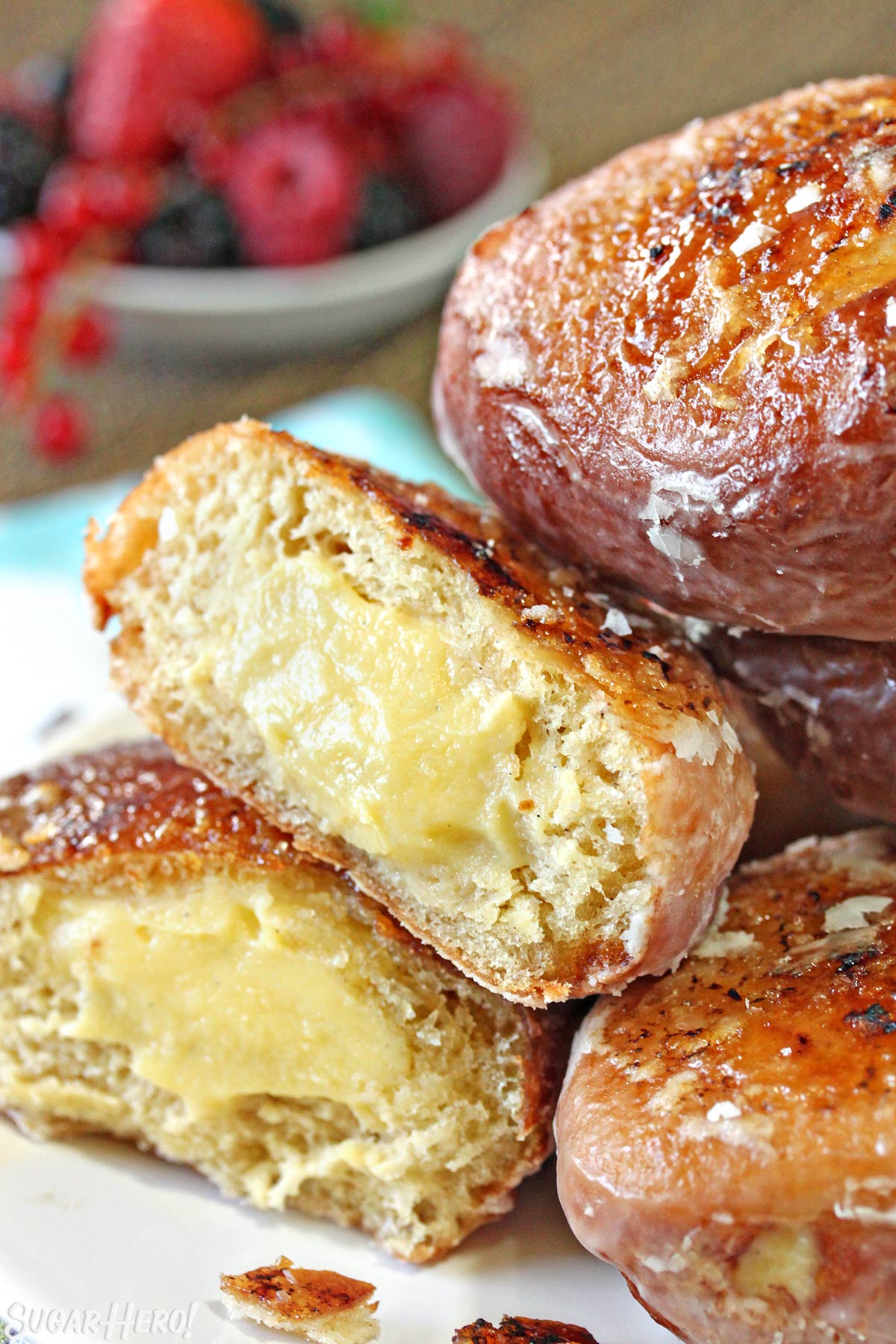
📋 How to make Crème Brûlée Donuts
Here’s a quick overview of how to make these doughnuts – you can grab the printable instructions down in the recipe card.
A quick caution before we begin — this recipe really benefits from an extended rising time, so please be sure to read through the whole recipe before beginning and make sure you have enough time for all the steps.
Because of the long rest, I recommend making this a two-day project: make the dough and the pastry cream one evening, and then the next morning you can roll, proof, and fry the doughnuts, then fill and finish them.
1. Make the doughnut dough
- Stir together yeast and warm milk in a mixing bowl and let it sit for 5-10 minutes, until the yeast has “bloomed” and there is a creamy foam on top of the milk.
- Add flour, sugar, salt, and eggs to the mixer bowl, and mix on low speed with a dough hook.
- Continue to mix while gradually adding softened butter to the dough.
- Mix for another 5 minutes until the dough is smooth, soft, and supple.
- Refrigerate the dough for at least 6 hours – overnight is fine too.
2. Roll and fry the dough
- Roll out the dough on a lightly floured surface.
- Cut out round circles of dough, and transfer them to a baking sheet.
- Let the doughnuts rise for 1-2 hours until they’ve doubled in size.
- Heat oil in a saucepan to 350 F, then fry the doughnuts until they’re golden brown.
3. Make the pastry cream
- Whisk together an egg, egg yolks, corn starch, and granulated sugar.
- In a saucepan, combine milk, sugar, and salt. Heat until the milk starts to simmer.
- Whisk the hot milk and egg yolk mixture together, then continue to heat and whisk until it thickens and starts to bubble.
- Remove the pan from the heat and whisk in butter and vanilla bean paste.
4. Assemble the doughnuts
- Make a quick glaze from powdered sugar and milk.
- Dip the doughnuts in the glaze, then let them sit so the glaze dries.
- Put the pastry cream in a piping bag, and fill the doughnuts with cream.
- Sprinkle the tops of the doughnuts with granulated sugar.
- Use a kitchen torch to toast the sugar until it bubbles and turns a deep amber color.
- Let the doughnuts cool and the caramel layer harden for about 5 minutes, then dig in!
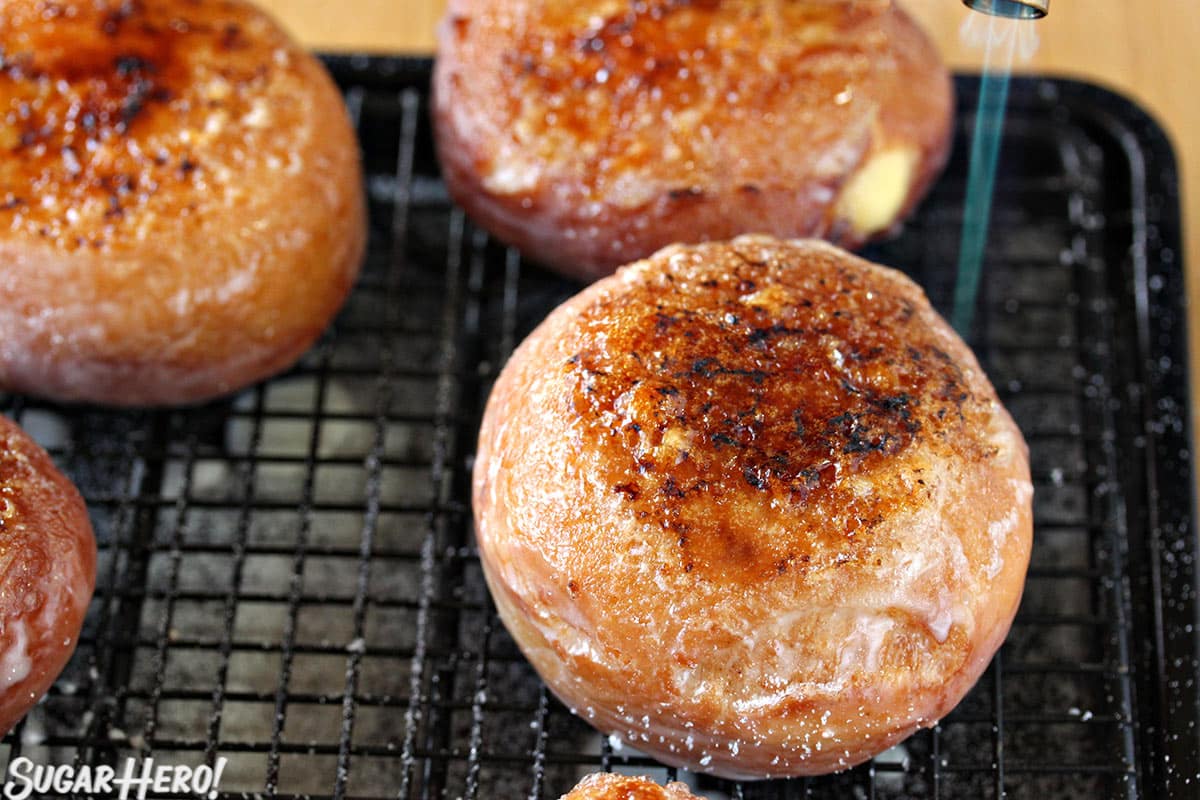
💭 Tips for Working With Yeast
Yeast has a reputation for being finnicky, but there’s no reason to be intimidated! If you’re new to yeast, here are a few best practices to make sure you and your yeast rise to the occasion. (groan-worthy pun intended).
- Always check the expiration date on the yeast package to make sure it hasn’t expired. While you can cook with expired yeast, provided it is still active, fresher yeast is more likely to be very active and produce a good rise.
- It’s a good idea to test some of your yeast before beginning. To test it, mix together 1 tsp sugar with 1/2 cup warm water. Add an envelope (2.25 tsp) of yeast, stir briefly, and let it sit for 10 minutes. If the mixture looks foamy and bubbles up, your yeast is good to go!
- Make sure the milk is warm but not hot when you add it to the yeast. Warm liquids help yeast grow, but if it’s too hot, you will kill the yeast. If you want to get particular about it, shoot for 100-110°F.
- A pinch of sugar during the proofing process can help the yeast activate, while adding salt will slow the activation. (And too much salt will kill the yeast altogether!) This recipe uses milk instead of water to proof the yeast, so the sugars in the milk are enough to encourage the yeast, and additional sugar is not needed.
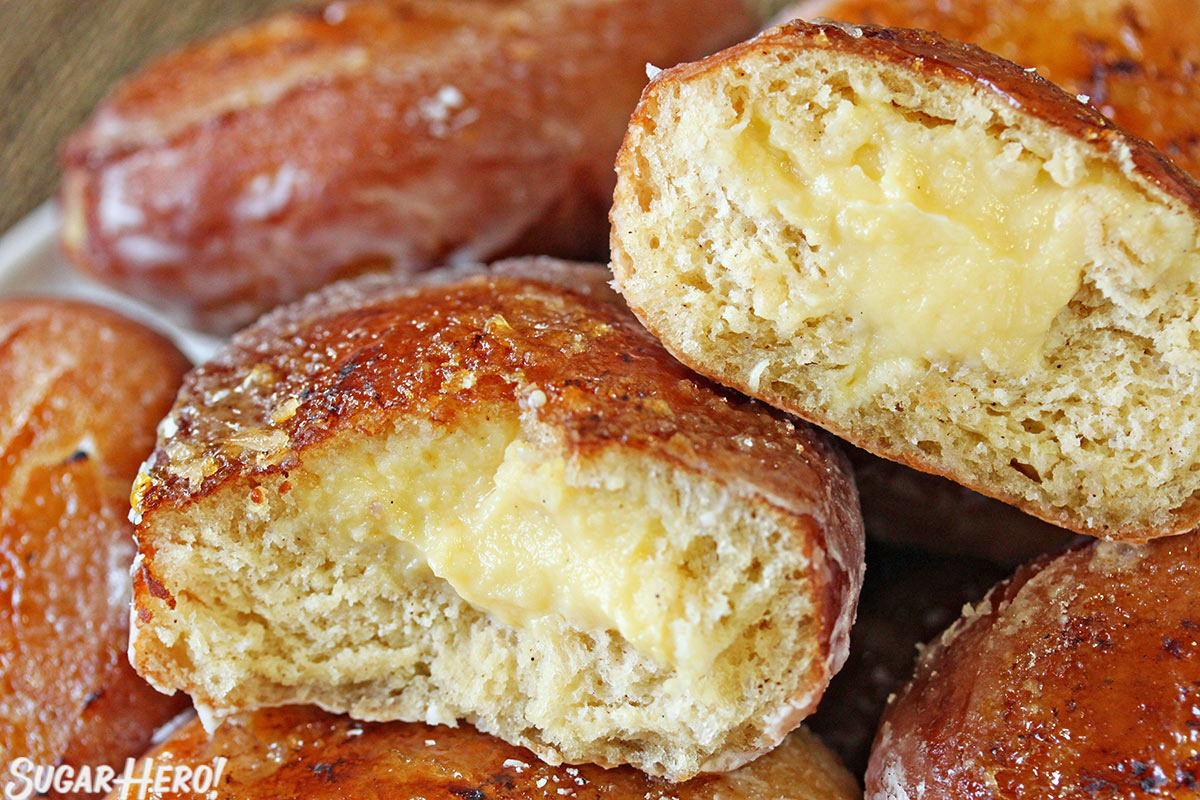
💡 Tips for Deep Frying
- Keep the burner at medium heat. It’s tempting to speed up the process and crank it to high heat, but soon enough that will cause your oil to overheat.
- Always use a thermometer to monitor the temperature of the oil. Not hot enough? Rather than turning up the burner, let the oil sit and heat up a bit longer before beginning to fry. Too hot? Turn down the heat or remove the pan from the burner briefly until it comes down to the correct temperature.
- Don’t overcrowd the pot by adding too many doughnuts at once.
- Use a slotted spoon or skimmer to lower the food into the oil.
- Make sure any food is completely dry before adding it to the hot oil. (Not as relevant when making doughnuts, but a good safety tip in general!)
- Protect your clothes and surfaces. Deep frying can get messy – oil splatters everywhere. Protect yourself by wearing an apron, and protect any delicate nearby surfaces or equipment by covering them with kitchen towels.
- Allow the food to drain on paper towels before serving.
❤️ More Breakfast Recipes
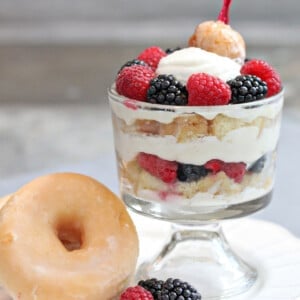
Doughnut Trifles
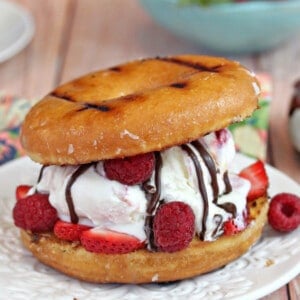
Grilled Doughnuts
Leave a Review!
If you make this recipe, let us know! Leave a ⭐️⭐️⭐️⭐️⭐️ rating on the recipe below, and leave a comment, take a photo and tag me on Instagram @elabau, or use #sugarhero on IG!
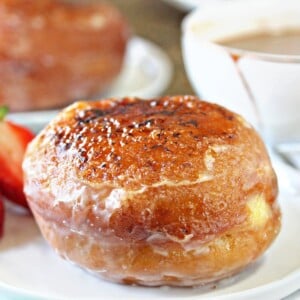
Crème Brûlée Donuts
Ingredients
FOR THE DOUGHNUTS:
- .25 oz active dry yeast, 1 package
- 2/3 cup milk, warm but not hot
- 15.75 oz all-purpose flour, (3 1/2 cups)
- 2.33 oz granulated sugar, (1/3 cup)
- 2 tsp salt
- 3 large eggs, at room temperature
- 3.5 oz unsalted butter, (7 TBSP), at room temperature
- 1 qt canola oil, for frying
FOR THE VANILLA PASTRY CREAM:
- 4 large egg yolks
- 1 whole large egg
- 3 TBSP cornstarch
- 3.5 oz granulated sugar, (1/2 cup), divided use
- 16 oz milk, (2 cups)
- pinch of salt
- 2 tsp vanilla bean paste, or 1 TBSP vanilla extract
- 2 TBSP unsalted butter
TO GLAZE AND FINISH:
- 8 oz powdered sugar, (2 cups)
- ⅓ cup milk, (up to 1/2 cup if needed)
- granulated sugar, to brulee the tops
Instructions
TO MAKE THE DOUGHNUTS:
- Stir together the yeast and warm milk in the bowl of a large stand mixer and let it sit for 5-10 minutes, until the yeast has “bloomed” and become a creamy foam on top of the milk. If your yeast hasn’t changed at all, it’s dead and you should start with a new batch.
- Add the flour, sugar, salt, and eggs to the mixer bowl, and mix on low speed with a dough hook for one minute, until the dough comes together to form a shaggy ball. Mix on low speed for an additional 2-3 minutes until it smooths out. After 2-3 minutes, continue mixing while you add the softened butter a tablespoon at a time. At first it might resist incorporating, but as you continue mixing, the butter will gradually work its way into the dough. After the butter is added, mix for another 5 minutes until the dough is smooth, soft, and supple.
- Wrap the dough tightly in plastic wrap, and refrigerate it for at least 6 hours, or overnight. The dough can be kept in the refrigerator for up to 15 hours. It will try to rise in the refrigerator, so it’s important to wrap it well.
- When you’re ready to roll the doughnuts out, lightly flour your work surface and sprinkle the top of the dough with a bit of flour. Cover a baking sheet with parchment and lightly flour the parchment as well. Roll the dough out until it is 1/2-inch thick. Use a round cutter about 2 3/4-inches to cut out circles, then transfer them to the baking sheet. Leave some room in between the doughnuts, since they will expand as they rise. Once you’ve cut out your first batch, gently press the dough back together, roll it out again, and cut out more doughnuts. You should get about 15 doughnuts from this batch.
- Cover the tray loosely with plastic wrap, then put it in a warm place to rise until doubled. Depending on the temperature and humidity of your kitchen, this could take anywhere from 1-2 hours.
- Once the doughnuts are risen, pour the oil into a medium sized pot so that it’s at least 2 inches deep. Insert a candy/deep-fry thermometer and heat the oil over medium heat until it’s 350 F. Cover a baking sheet with several layers of paper towels.
- Working in batches, carefully slide 2-3 doughnuts into the hot oil (depending on the size of your pot—don’t crowd them!). Fry them for about 2 minutes per side, until they’re puffed and golden brown on both sides. Use a frying spatula or slotted spoon to transfer the doughnuts to the paper towel-covered tray. Repeat with the remaining doughnuts, keeping an eye on the thermometer often. If the oil gets too hot, turn the heat down or remove it briefly from the stove, and if it gets too cool, pause your frying until it has a chance to heat up again.
- Once all of the doughnuts are fried, let them cool completely before filling them.
TO MAKE THE VANILLA PASTRY CREAM:
- In a medium bowl, whisk together the egg yolks, whole egg, corn starch, and 1.75 oz (1/4 cup) of granulated sugar. In a medium saucepan, combine the milk, remaining 1.75 oz (1/4 cup) of granulated sugar, and salt. Heat the milk over a medium burner until it just starts to boil. Start whisking the egg mixture, and while you’re whisking, drizzle a little hot milk into the eggs. Continue to whisk and drizzle until you’ve added about half of the milk. Switch to whisking the milk, then pour the eggs into the milk mixture while whisking.
- Return the pan to the burner and heat the cream, whisking constantly. Use a rubber spatula to periodically scrape the bottom of the pan so it doesn’t scorch. Cook until the pastry cream thickens and starts bubbling very gently. Then cook for 1-2 minutes longer. Remove the pan from the heat and whisk in the vanilla bean paste or extract, and unsalted butter.
- Pour the cream through a wire mesh strainer into a bowl. It will be somewhat thick, so use a spatula to help work it through, straining out any clumps of egg that have developed. Press a layer of cling wrap directly on top of the pastry cream, and let it cool to room temperature. Once at room temperature, refrigerate it until it’s cold, at least 2 hours.
TO ASSEMBLE:
- To make the glaze, whisk together the powdered sugar and 1/3 cup milk. Check the texture: you want the glaze to flow freely from the whisk and drop back into the bowl quickly, but it should be thick enough to coat the doughnuts and not immediately disappear or run off the sides. Add more milk if necessary, to get a texture you like. Cover a baking sheet with a wire rack.
- Dip a doughnut in the glaze, turning it so both sides are coated, then lift it up out of the glaze using a spatula or fork. Place it on the wire rack and let the excess glaze drip down. Repeat until all of the doughnuts are glazed. Let the glaze set for 10 minutes before proceeding.
- Place the pastry cream in a piping bag fitted with a small round tip—I used a #10 tip with an opening about 1/4-inch wide. Poke the tip into the side of a doughnut and squeeze the bag to fill the doughnut with cream. Stop when you feel resistance, and slowly pull the bag out. Repeat until all of the doughnuts are filled with pastry cream.
- Sprinkle the tops of the doughnuts with an even layer of granulated sugar, and torch them with a kitchen torch until the sugar bubbles and turns a deep caramel brown. If you don’t have a kitchen torch, you can try to use your oven’s broiler, but the results will probably be more uneven. Place a rack right underneath the broiler and watch the doughnuts every second while they broil—it will probably take under a minute for the sugar to melt and bubble.
- Let the doughnuts cool and the caramel layer harden for about 5 minutes, then dig in!
Recipe Notes
Measuring Tips
Our recipes are developed using weight measurements, and we highly recommend using a kitchen scale for baking whenever possible. However, if you prefer to use cups, volume measurements are provided as well. PLEASE NOTE: the adage “8 oz = 1 cup” is NOT true when speaking about weight, so don’t be concerned if the measurements don’t fit this formula.
Want to learn more about baking measurements and conversion?

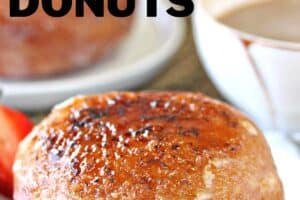
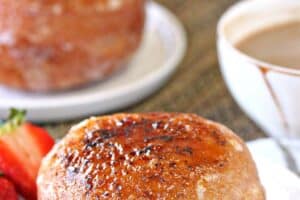
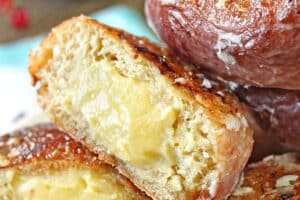
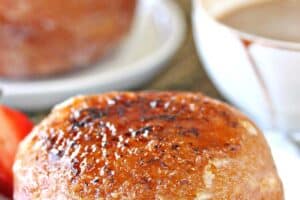




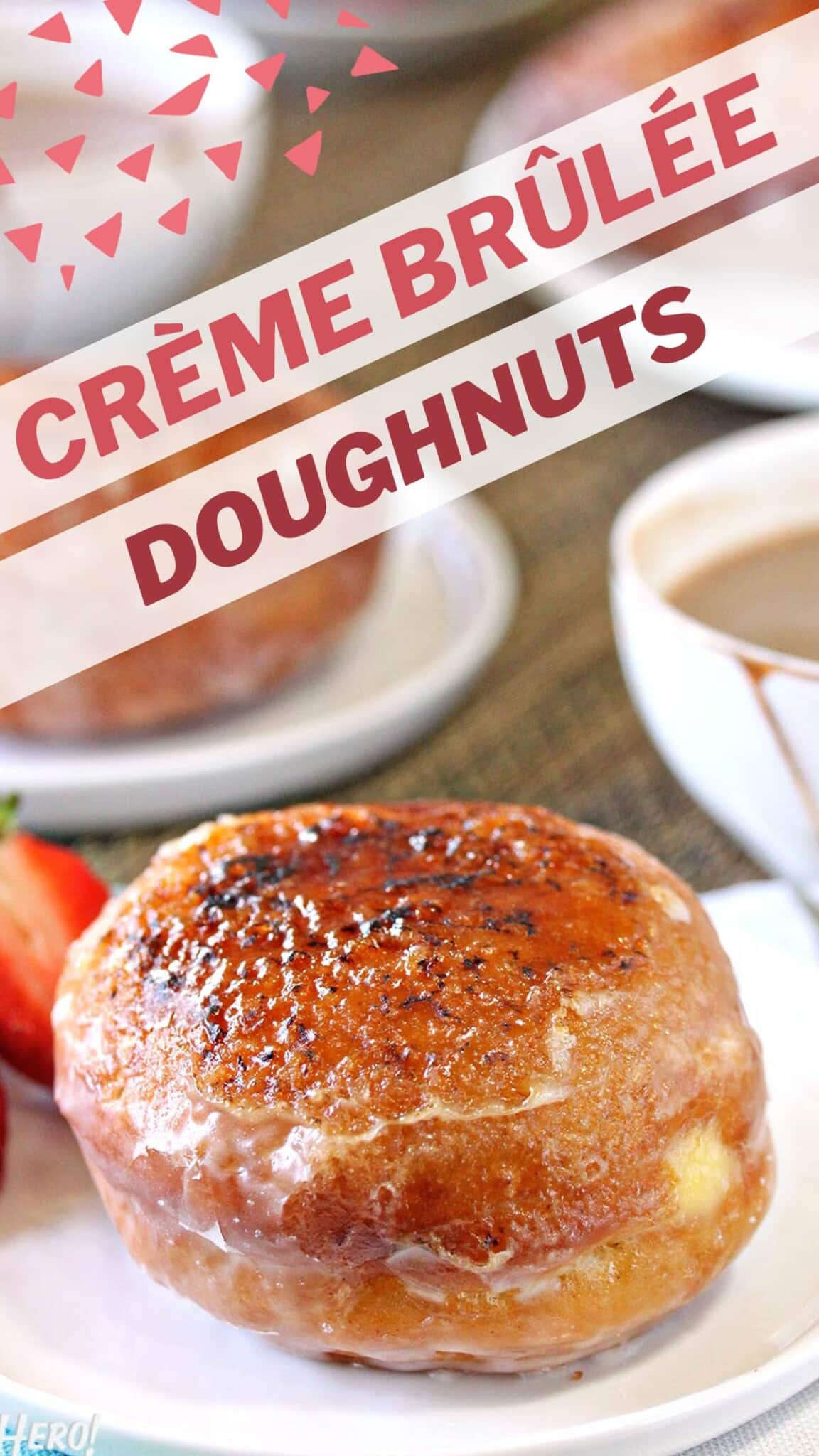
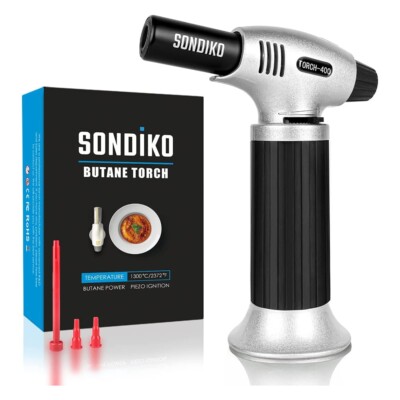
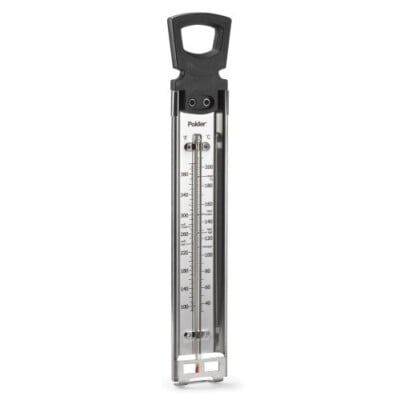
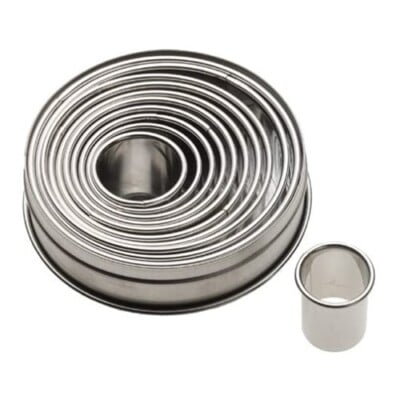
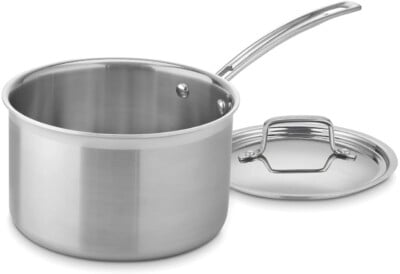
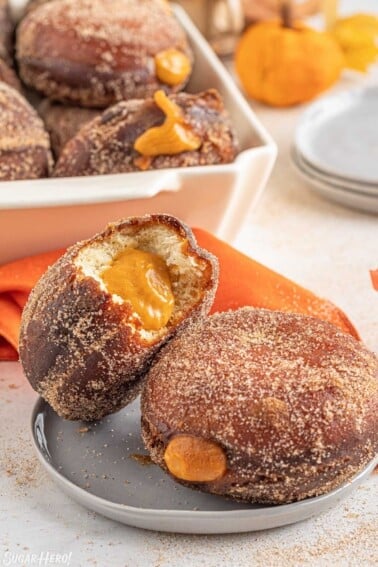
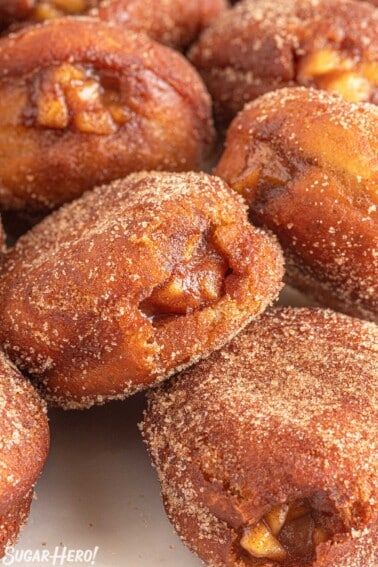
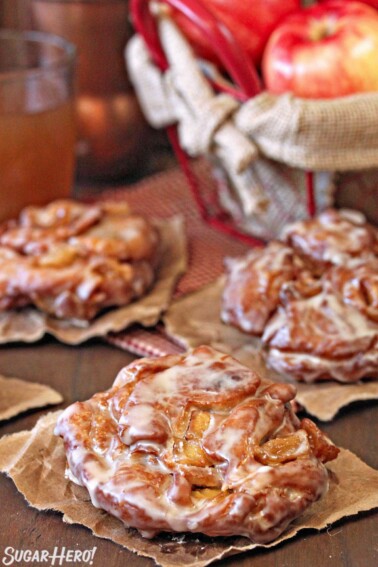
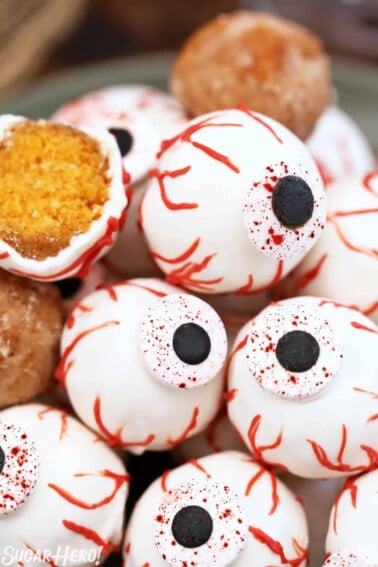












Hi. What happens if I leave the dough for 20 hours because I can’t get to it sooner? Thanks for any help.
Hi Aggie, the concern is that the dough might become “overproofed”–this means that it has risen too much. Overproofed breads/doughnuts can have a tough texture and can even collapse during baking. The proofing time can really vary depending on the temperature of the refrigerator and the yeast used, so it’s possible 20 hours might be fine, but it’s also possible you might be disappointed with the outcome. I hope you’ll let me know how it goes if you give it a try!